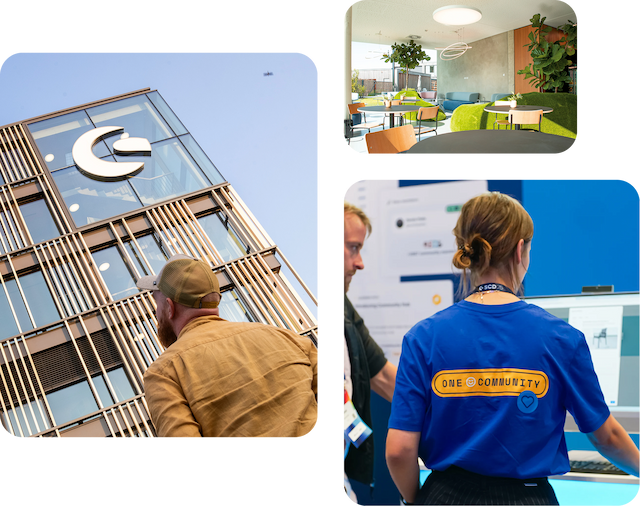
The online industry is growing rapidly and demands adaptable shop systems. You have a tough choice: many platforms offer shop systems, but which one suits your project?
Here, you’ll learn what to look for in features, security, and scalability. You’ll see how different systems handle high-load scenarios and where hidden costs may arise.
Fundamental differences between shop systems
On-Premise vs. Cloud-Hosting
The market for ecommerce tools is diverse, and each system comes with its own advantages. An important question is: Where will you host your shop? Often, the choice is between on-premise or cloud hosting, with each model bringing different requirements. This helps you keep track when deciding on one of these concepts.
On-premise means you manage your own servers, giving you full control over hardware and maintenance. This can be worthwhile if your team has technical expertise and you already have suitable infrastructure. However, the effort for maintenance and updates increases once you want to handle larger order volumes.
Cloud hosting doesn’t require your own servers, which speeds up the start. You pay a monthly fee and don’t have to worry about hardware issues. This gives you more flexibility but can create dependencies on the chosen provider. Pay attention to how easily you can increase your capacity later if your product range and visitor numbers grow.
Headless vs. Monolith
A monolithic system combines all components into a single system. This means you have everything in one user interface, which initially seems very practical. However, with large projects, limits can appear when you want to add new features. The more tightly the modules are connected, the more complicated it becomes to adjust individual areas.
A headless system clearly separates frontend and backend. This allows you to flexibly connect different channels like web, app, or kiosk without having to overhaul the entire framework. If you plan updates, the shopping experience remains stable because changes in the backend don’t necessarily affect the layout or usability.
Beginner vs. Enterprise
Some shop systems target startups with manageable product ranges. Here, it’s important to be able to start quickly and have a user-friendly interface. These offerings often cover basic functions without requiring lengthy configurations. In return, the options can be limited if you want to expand significantly later.
Enterprise versions play to their strengths when it comes to large data volumes and high order frequencies. Tens of thousands of products or thousands of transactions per minute pose no obstacle here. Such systems also often offer extensive interfaces to ERP or CRM, simplifying complex processes. This works well once your shop has grown considerably and you want to centrally manage various processes.
Basic functions a shop system should offer
Shop Management: A clear backend for products, orders, and customer data.
Design Flexibility: Customizable templates and mobile optimization.
Payment Methods: Support for credit cards, PayPal, Klarna & others.
Customer Accounts: Self-service for orders, invoices, and address management.
Marketing & SEO: Optimized URLs, meta-data, coupons, and cross-selling.
Analytics & Reporting: Real-time sales and visitor statistics.
Shipping Options: Interfaces to DHL, UPS & custom shipping cost calculations.
Internationalization: Multilingual support and currency options.
Data Protection & Security: SSL encryption and GDPR compliance.
Expandability: API interfaces for ERP, CRM, and accounting.
This article contains a self-introduction by Shopware as part of a market overview. Despite careful research, it should not be understood as an objective test report but rather as an editorial comparison with promotional elements (as of July 2025).
8 popular shop systems compared
1) Shopware
Origin and Concept: Shopware is an ecommerce system developed in Germany.
Technology: It has a modular structure and can be customized in many areas. Thanks to its API-first approach, it is highly scalable.
Target Audience: Its main use is for large and internationally active companies in Europe. Shopware supports multiple languages, various currencies, and country-specific tax rates.
Adaptability: High flexibility through open-source architecture, API-first, and headless design.
Scalability: Suitable for businesses of all sizes with growing demands.
B2B Functionality: Comprehensive features for B2B business models.
Community Support: Active developer community and extensive documentation.
Plans & Pricing (as of July 2025)
Shopware offers different plans to meet the needs of various users:
Community Edition: Free open-source version with basic features
Rise: Starting at €600 per month
Evolve: Starting at €2,400 per month
Beyond: Starting at €6,500 per month
In addition to the monthly fees, additional costs may apply, such as:
Hosting: For the self-hosted option, costs for servers and infrastructure apply.
Extensions: Costs for plugins and themes from the Shopware Store.
* Self-presentation
2) Shopify
Origin and Concept: Shopify is a cloud-based service (“Software as a Service”) founded in Canada.
Technology: Hosting is included with Shopify, and extensions can be obtained through its own “App Store.”
Target Audience: According to the company, Shopify is used worldwide by a variety of businesses, from small shops to larger retailers.
User-Friendliness: Easy to use without technical knowledge.
Quick Start: Integrated hosting solution with pre-designed templates.
Multi-Channel Sales: Integration with social media and marketplaces.
Extensive App Store: A wide range of extensions available.
Plans & Pricing (as of July 2025, source: Shopify)
Shopify offers three pricing plans (prices based on monthly billing):
Basic: €36 per month; suitable for new ecommerce businesses with basic requirements.
Shopify: €105 per month; offers additional features like professional reports and advanced staff accounts.
Advanced Shopify: €384 per month; includes advanced reporting features and lower transaction fees.
In addition to the monthly fees, additional costs may apply, such as:
Transaction fees
Costs for apps and themes
Shopify offers a 25% discount on annual subscriptions for the Basic, Shopify, and Advanced plans.
3) Adobe Commerce
Origin and Concept: Adobe Commerce evolved from Magento and is now part of Adobe.
Technology: According to the provider, it includes extensive features for both B2C and B2B.
Target Audience: According to the manufacturer, the platform is used by both medium-sized and large companies.
Adobe Ecosystem: Access to a wide range of Adobe tools.
Scalability: Suitable for businesses of all sizes with growing demands.
Omni-Channel Capability: Integration of various sales channels.
Plans & Pricing (as of July 2025, source: Adobe)
Adobe Commerce is generally available in two packages: Adobe Commerce Pro and an additional Managed Services option, which Adobe says minimizes risks and disruptions.
Pricing is based, among other factors, on the annual Gross Merchandise Value (GMV) and the Average Order Value (AOV). A precise quote requires a request.
In addition to licensing fees, additional costs may include:
Hosting: Depending on the chosen deployment option (on-premise or cloud).
Implementation: Costs for development and customization of the shop.
Extensions: Fees for additional modules and plugins.
Support and Maintenance: Ongoing costs for updates and technical support.
4) WooCommerce
Origin and Concept: WooCommerce is a WordPress plugin that adds online shop functionality.
Technology: It can be extended through themes and plugins.
Target Audience: It is mainly used by shops that already use WordPress or want to combine content and shop features.
Flexibility: Customizable through numerous themes and plugins.
Cost: Basic usage is free.
Community Support: Large developer community with extensive documentation.
Plans & Pricing (as of July 2025, source: WooCommerce)
The WooCommerce plugin itself is free. However, running a WooCommerce shop can incur the following additional costs:
Hosting: Depends on the provider; typically between €5 and €100 per month.
Domain: Varies widely; around €5–20 per year.
SSL Certificate: Necessary for secure data transmission; costs vary.
Premium Themes: One-time cost of about €50.
Plugins and Extensions: Additional fees may apply depending on functionality.
Development and Maintenance: For customizations, programming costs typically range from €20 to €150 per hour.
5) BigCommerce
Origin and Concept: BigCommerce is a software-as-a-service (SaaS) platform with hosting provided by the vendor.
Technology: SEO and marketing features come pre-configured and can be used depending on the plan.
Target Audience: The system offers interfaces to integrate inventory management and CRM tools.
Multi-Channel Commerce: Built-in support for MCC (Multi-Channel Commerce).
Advanced Marketing Features: Includes tools like cart abandonment recovery, etc.
Internationalization: Strong support for globally operating businesses (currencies, shipping, payments).
Plans & Pricing (as of July 2025, source: BigCommerce)
BigCommerce offers various pricing plans (prices based on monthly billing):
Standard: $39 per month; suitable for smaller businesses with basic needs. Up to $50,000 in online sales.
Plus: $105 per month; offers advanced marketing tools and customer segmentation. Up to $180,000 in online sales.
Pro: $399 per month; for businesses with higher sales volume and advanced features. Up to $400,000 in online sales.
Enterprise: Custom pricing; tailored solutions for large companies with special requirements.
6) Wix
Origin and Concept: Wix is a provider of website builder solutions, supplemented with ecommerce features.
Technology: The provider offers drag-and-drop functionality and design templates on its website.
Target Audience: The offering is designed for individuals and businesses who want to quickly create their own website with a shop.
Easy to Use: Intuitive drag-and-drop interface enables a quick start.
Design Templates: Over 900 customizable templates available.
Integrated Features: Hosting, domain, and SEO tools are included.
Pläne & Preise (as of July 2025, source: Wix)
Wix offers various packages for online shops:
Light: Starting at €13.09 per month; suitable for individuals and first steps in website building. No ecommerce features.
Core: Starting at €26.18 per month; suitable for small shops with basic functions.
Business: Starting at €40.46 per month; offers advanced ecommerce features and better support.
Business Elite: Starting at €177.31 per month; provides an extended developer platform.
Additional costs may include:
Domain: Usually around €14.95 per year from the second year onwards. More expensive for “.shop” or “.store” domains.
Email Mailboxes: Wix links your domain to G Suite for €72 per year.
7) Spryker
Origin and Concept: Spryker is a commerce solution developed in Germany.
Technology: Spryker is based on a modular, headless, and API-first architecture.
Target Audience: According to the company, Spryker is used by businesses with extensive customization needs, especially in the B2B sector.
Modular Structure: Allows for individual customization.
Packages: Specialized packages for different needs, such as B2B and B2C.
Headless API-First: Enables separation of backend and frontend.
Plans & Pricing (as of July 2025, source: Spryker)
Like other providers, Spryker offers flexible pricing. There are four packages: B2B Commerce, Enterprise Marketplace, Unified Commerce, and, more recently, B2C Commerce.
Spryker does not provide any example pricing information for these packages on their website.
8) Commercetools
Origin and Concept: Commercetools is a German company that offers a cloud commerce platform.
Technology: Commercetools provides a microservices, API-first, and headless approach.
Target Audience: According to the company, it targets businesses seeking scalable and highly customizable commerce solutions.
Real-Time Control: Well-suited for personalizations and recommendations in the online shop.
API: Users report impressive API speed.
Adaptable: Commercetools is highly flexible and can be customized to individual needs.
Plans & Pricing (as of July 2025, source: Commercetools)
Commercetools does not disclose pricing or package details on its website.
How to find your ideal shop system
Besides the clearly comparable points, you should always think a bit further. Ideally, you want to keep your shop system for several years. To find the right one for you, in addition to the provided data, you should also consider the following points.



Additional tips:
Before making your choice, be clear about how quickly you want to grow, how much budget you have, and how important customizations are to you. This way, you’re more likely to find the shop system that will make you happy in the long run. If you have technical questions, it’s always worthwhile to consult with developers or agencies specialized in the respective system.
Think carefully about your main goals (e.g., quick launch, custom features, design focus, international growth, etc.).
Check how good the support and community are in your region.
If you need scalability, performance, and high customization, a powerful system is indispensable.
Is Shopware the right shop system for you?
If Shopware has convinced you, you can book your personal demo directly here. There, you’ll get an inside look at the system and learn how to best use Shopware for your project.
Shop systems in comparison – Frequently Asked Questions (FAQ)
What is the difference between a monolithic and a modular shop system?
A monolithic shop system includes all functions within a single codebase, which makes management easier but offers less flexibility. Modular systems allow you to assemble specific features, so merchants can use only the components they need and scale more easily.
How does the choice of a shop system affect the conversion rate?
A fast, intuitive, and mobile-optimized shop system reduces bounce rates and increases the likelihood of purchase. Features like an optimized checkout process, personalized product recommendations, and easy payment options enhance the user experience and boost sales.
What technical requirements should a shop system meet?
The shop system should run on a stable hosting infrastructure that provides enough performance to handle high traffic and order volumes. An API-first architecture makes it easier to connect external tools and ensures long-term compatibility with new technologies.
What role does artificial intelligence play in modern shop systems?
Artificial intelligence helps analyze customer behavior, optimize product recommendations, and automate processes like pricing and inventory management. Shop systems use algorithms to generate targeted suggestions for customers and simplify administrative tasks.
How does Shopware support B2B companies in ecommerce?
Shopware offers dedicated B2B features such as customer-specific pricing, fast ordering processes, and comprehensive self-service portals. Its API-first architecture allows direct integration with ERP and CRM systems, helping to automate complex business workflows.
What are the advantages of Shopware’s open-source architecture?
Thanks to its open-source approach, Shopware allows complete customization of the shop to meet specific business requirements. Developers can build custom features, and a large community continuously provides new extensions and security updates.
How important is headless commerce for future shop systems?
Headless commerce separates the frontend from the backend, allowing for flexible control of various sales channels. It offers benefits like faster load times, improved user experience, and the ability to deliver content across websites, apps, or marketplaces in a targeted way.











